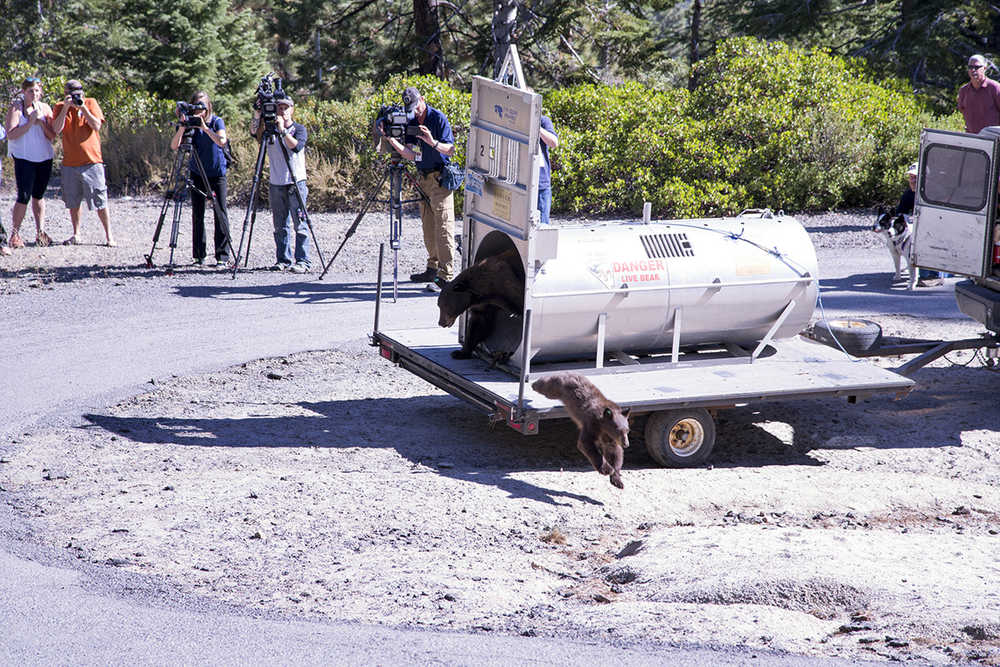RENO, Nev. — Are some bears just born to be bad? Or do they learn from other bears that raid garbage cans, break into cars and homes and eventually have to be killed because they’ve lost their fear of humans?
Scientists have researched this classic debate over “nature” and “nurture” among black bears for decades, from Yosemite National Park in the Sierra to central Florida and the Adirondacks in upstate New York.
Now, a notorious 19-year-old female bear at Lake Tahoe with a rap sheet a mile long has become a poster child of sorts for the kind of generational cycle that experts say her young will be hard pressed to break as long as humans continue to leave garbage in their reach.
Last week, Nevada wildlife officials were forced to euthanize a young problem bear at the lake — the third offspring killed from the same litter born to the mama bear known by her tag number, Green 108.
“She’s just kind of a chronic, nuisance-type bear,” said Carl Lackey, a wildlife biologist for the Nevada Department of Wildlife. “She’s always been getting into trash, always been in the same area. We’ve captured several litters of hers. We’ve captured her several times.”
Lackey co-authored a 2008 study published in the Journal of Mammalogy about the role of genetics in bear conflict behavior.
“We sort of concluded that genetics alone could not explain a nuisance behavior in black bears,” Lackey said about the research led by S.W. Breck and C.L. Williams at the USDA’s National Wildlife Research Center in Fort Collins, Colorado.
A study led by National Park Service researchers first suggested in 1989 that problems with Yellowstone’s grizzly bears were a function of behavior passed from mother to offspring and successive generations, but it didn’t determine whether it was learned or inherited.
Another 2008 study by Rachel Mazur and Victoria Seher, researchers at Yosemite’s Division of Resources Management, documented bears “actively tutoring” their cubs to find food in human environments. They concluded that food-conditioned foraging is a skill passed from older bears to the young.
“We have observed sows pushing cubs into buildings and vehicles to retrieve food rewards,” they wrote.
Lackey said several bears that have been caught at Tahoe multiple times and released back into the wild “won’t go into a trap anymore.”
“They send their cubs into the trap or cubs into homes to get food,” he said.
Nevada Department of Wildlife spokesman Chris Healy witnessed something similar last summer at a trap set in Reno.
“Cubs showed up curious about the trap, and the sow we caught a year before would sit there and growl at the cubs to scare them away,” Healy said.
“We’re dealing with really smart animals that become habituated to food,” he said. “If you want to solve the problem, you have to change the way you deal with garbage.”
National parks across the West long have utilized bear-proof trash containers. Several communities in the Canadian Rockies started requiring bear-proof garbage cans as early as 1999. A few U.S. towns have made them mandatory, including parts of Boulder, Colorado, last year. But others — including Lake Tahoe — have rejected attempts because of costs and opposition to government regulation.
Mazur and Seher examined in 2008 whether the bears simply were adapting to their environment, or whether “previously adaptive behavior” became counter-productive, putting the animals in the way of harm by increasing contact with humans. While the garbage provides high-energy food, those bears were 5.6 times more likely than cubs of wild sows to be hit by cars, hunted or killed for safety reasons, they found.
In the end, the bears fall into an ecological trap, they wrote.
So is society ultimately to blame for problem bears like Green 108 and her cubs? Lackey thinks so.
“If we could have waved a magic wand and bear-proofed Tahoe years ago, you wouldn’t see the number of bears getting into these conflict situations,” he said.
Healy said Tahoe never had a serious bear problem until the early 1990s when food sources dwindled in the mountains during extended drought.
“That drought drove bears out of the back country, and a lot of them never left,” he said.

